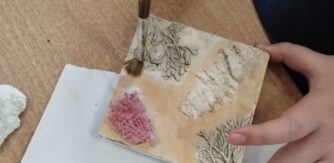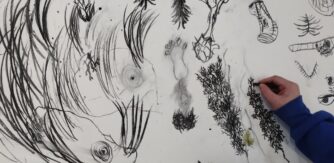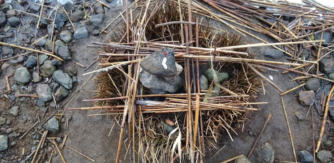Blag 4 – An Dr Jo Lewis, Ealaíontóir & Faighteoir na Dámhachtana Sparánachta do Dhaoine Óga, Leanaí agus Oideachas ón gComhairle Ealaíon
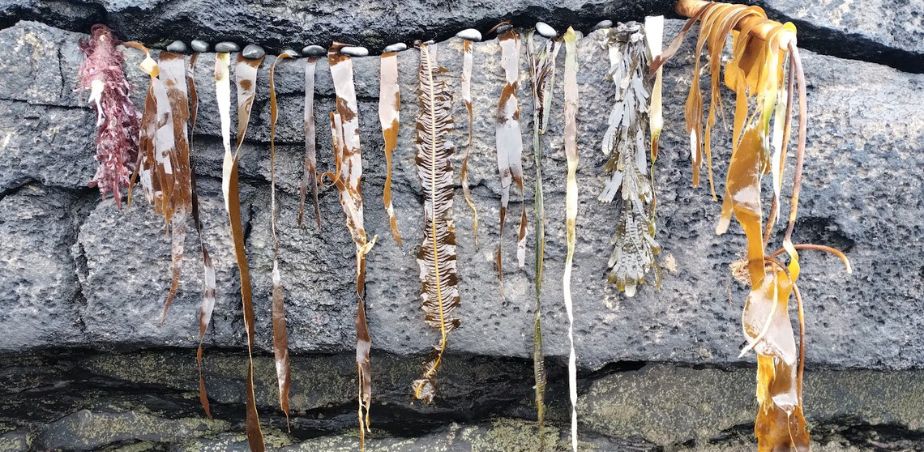
Tionscadal chonair na maighdine mara, Scoil Náisiúnta Ráth Lao, Co. Shligigh

Ghnóthaigh Jo Lewis céim Bhaitsiléara Ealaíon sa Mhínealaín in Coventry agus céim Mháistreachta i Mínealaín sa Dealbhóireacht ó Scoil Ealaíne Birmingham. Bhí stiúideo aici i stiúideonna SPACE Londan ar feadh roinnt blianta, áit ar oibrigh sí agus ar chuir sí saothair ar taispeáint agus í ag reáchtáil na bialainne veigeatóra 100 suíochán, Heather’s, san am céanna, in éineacht lena páirtí.
In 2002, d’aistrigh Jo ó Londain go Co. Liatroma lena páirtí agus lena gclann óg gur chóirigh siad seanteachín cloiche, chun ‘saol maith’ a bheith acu.
Le linn an ama seo, ghnóthaigh sí PhD ag SOAS (Scoil na Staidéar Oirthearach agus Afracach) as a cuid taighde ar Ealaíontóirí Mná na Botsuáine. Tá an tráchtas s’aici anois faoi choimeád Leabharlann na Breataine.
D’oibrigh Jo ar an tionscnamh BLAST (Ealaín Bheo a Thabhairt chuig Daltaí agus Múinteoirí) agus theagasc sí i scoileanna ar fud chontae Shligigh. Le déanaí, le haghaidh na mionchónaitheachtaí seo i scoileanna, dhírigh Jo ar na daltaí a thabhairt amach faoin spéir chun ealaín a dhéanamh agus inspioráid a fháil. D’úsáid sí tírdhreach áitiúil mar chúlra chun tumadh isteach in éiceolaíocht na háite tríd an ealaín.
In 2023, bhronn Comhairle Ealaíon na hÉireann sparánacht ar Jo chun rud beag taighde a dhéanamh ar an gcomhéadan idir an ealaín agus an éiceolaíocht san oideachas scoile mar bhealach chun spéis a mhúscailt i measc páistí i leith a dtimpeallachta.
Conas páistí a chur ag plé le géarchéim na haeráide ach tuiscint a fháil ar an éiceolaíocht trí chleachtas ealaíne.
Tá dúshlán ag baint leis an ngéarchéim aeráide a fhiosrú agus tá ar gach oideoir foghlaim le dul i ngleic go han-tapa leis faoi láthair. Sa cheathrú blag den tsraith, an blag deireanach ón ealaíontóir Jo Lewis, féachann Jo ar an gcaoi ar féidir leis an ealaín agus an éiceolaíocht cuidiú le dul i ngleic leis an tsaincheist seo, agus an faitíos a bhaineann léi á íoslaghdú ach leas a bhaint as an dearfacht trí nasc leis an dúlra.
Ní féidir a shéanadh ná a bheith in amhras gurb ann don ghéarchéim aeráide. Toisc go mbíonn na téarmaí á gcaitheamh thart agus á n-úsáid ar bhonn laethúil, tá ar na hoideoirí iad a chur ina gcuid teagaisc chun tuiscint a léiriú go bhfuil eagla orainn maidir leis an todhchaí ach straitéisí a aimsiú chun déileáil leis an eagla sin agus dóchas a chothú san am céanna.
Is féidir le leanaí plé leis an dúlra ar shlí uathúil mar gheall ar an ealaín, rud a ligeann dóibh breathnú ar an timpeallacht agus nasc a chothú léi ar leibhéal domhain. Le cleachtais ealaíne, bíodh líníocht, grianghrafadóireacht nó bailiú samplaí fiú i gceist leis sin, is féidir cabhrú le leanaí a dtimpeallacht “a léamh” agus braistint mhuintearais a fhorbairt leis an talamh ar a maireann siad. Nuair is féidir le scoláirí plandaí a shainaithint nó patrúin a aithint sa tírdhreach, faigheann siad tuiscint níos dlúithe ar an timpeallacht, rud lena gcothaítear an fhiosracht agus an fhreagracht.
Is féidir leis an ealaín saol na héiceolaíochta a nochtadh, agus nuair a ritear ceardlanna ealaíne amuigh faoin spéir, is féidir baint níos dlúithe a bheith ag leanaí leis an dúlra. Ní gá cúlra éiceolaíochta a bheith ag an múinteoir ealaíne. Is féidir leis an scoláire agus an múinteoir a bheith ag foghlaim le chéile. Beidh ar an múinteoir an rang a threorú ach ní gá na freagraí ar fad a bheith acu.
Seo roinnt bealaí chun an ealaín agus an éiceolaíocht a shní isteach sa cheacht:
- Líníocht: Spreag na scoláirí le plandaí, crainn agus gnéithe eile den tírdhreach a sceitseáil. Is cuma cé acu mionsonraithe nó tapa atá na sceitsí, cabhraíonn an cleachtas sin leo mionsonraí a dtimpeallachta a thabhairt faoi deara.
- Grianghrafadóireacht: Bain úsáid as an ngrianghrafadóireacht chun áilleacht an dúlra a ghabháil. Spreagann an modh seo an phointeáilteacht agus ligeann sé do na leanaí plandaí agus feithidí, nach bhfeicfidís murach sin b’fhéidir, a thaifeadadh.
- Bailiú agus Preasáil: I gcás plandaí nach bhfuil faoi chosaint, is bealach inláimhsithe é bailiú agus preasáil samplaí chun an dúlra a fhiosrú. Chomh maith leis sin, is féidir plandaí preasáilte a úsáid le haghaidh tionscadail ealaíne, lena bhfeabhsaítear an caidreamh atá acu leis timpeallacht.
Nuair a spreagtar leanaí tríd an ealaín agus an éiceolaíocht, ní hamháin go gcabhraítear leo an domhan mórthimpeall orthu a thuiscint, ach cumasaítear iad chun beart a dhéanamh. Cothaítear cruthaitheacht, breathnóireacht, agus tuiscint ar fhreagracht leis an ealaín, agus leis an éiceolaíocht teagasctar do na leanaí an tábhacht a bhaineann le caomhnú agus cosaint an phláinéid. Is féidir leis na cleachtais sin, in éineacht lena chéile, dóchas a spreagadh agus na scileanna a thabhairt don chéad ghlúin eile dul i ngleic leis an ngéarchéim aeráide go diongbháilte agus caidreamh athnuaite acu leis an dúlra.
Roinnt acmhainní úsáideacha:
- Reáchtálann an Taisce cúrsaí samhraidh chun acmhainní a thabhairt do mhúinteoirí: greenschoolsireland.org/an-taisce-summer-courses-2024/
- Déan beart dearfach: Clár Eolaíochta Saoránach NASA
- “Teach Your Kids About Climate Change Art” le Jess Farraday
Gabhaim buíochas leis an gComhairle Ealaíon as a deontas do Dhaoine Óga, Leanaí, agus Oideachas, deontas a chuir ar mo chumas taighde agus taifeadadh a dhéanamh ar thrasnú na healaíne agus na héiceolaíochta sa seomra ranga. Bhí an obair sin spreagúil agus d’fhoghlaim mé go leor uaithi, agus tá súil agam go spreagfaidh sé oideoirí cleachtais timpeallachta chruthaitheacha a úsáid ina gcuid teagaisc. Má tá tuilleadh eolais ó aon duine maidir leis an taighde sin, ná bíodh aon drogall oraibh dul i dteagmháil liom.
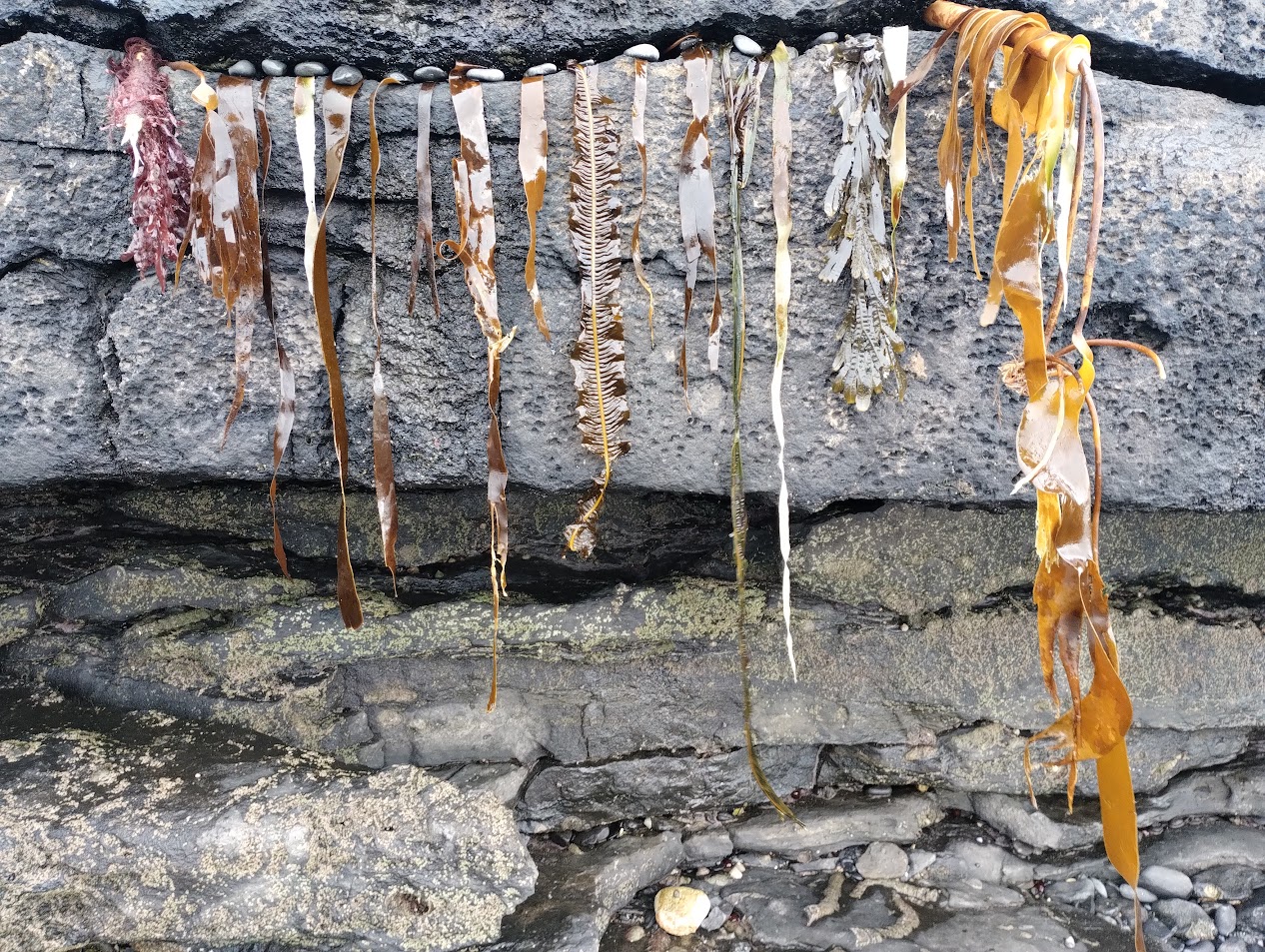 Íomhá 1: Tionscadal chonair na maighdine mara le Scoil Náisiúnta Ráth Lao, Co. Shligigh
Íomhá 1: Tionscadal chonair na maighdine mara le Scoil Náisiúnta Ráth Lao, Co. Shligigh
 Íomhá 2: Turas allamuigh chuig portach an Chluainín, Scoil Náisiúnta na Gaobhaí leis an ealaíontóir Jo Lewis.
Íomhá 2: Turas allamuigh chuig portach an Chluainín, Scoil Náisiúnta na Gaobhaí leis an ealaíontóir Jo Lewis.
 Íomhá 3: Ealaín agus éiceolaíocht ag Stiúideo an tSathairn ag The Dock, Co. Liatroma. Saothair ealaíne ar thíleanna a léiríonn crainn, duilleoga agus síolta.
Íomhá 3: Ealaín agus éiceolaíocht ag Stiúideo an tSathairn ag The Dock, Co. Liatroma. Saothair ealaíne ar thíleanna a léiríonn crainn, duilleoga agus síolta.
 Íomhánna ó chlé go deas: Ealaín trá ag an Mullach Mór, Scoil Náisiúnta Bhéal Átha an Trí Liag, Caonach móna ag portach an Chluainín, Scoil Náisiúnta na Gaobhaí, agus tionscadal chonair na maighdine mara, Scoil Náisiúnta Ráth Lao
Íomhánna ó chlé go deas: Ealaín trá ag an Mullach Mór, Scoil Náisiúnta Bhéal Átha an Trí Liag, Caonach móna ag portach an Chluainín, Scoil Náisiúnta na Gaobhaí, agus tionscadal chonair na maighdine mara, Scoil Náisiúnta Ráth Lao
Gach grianghraf le caoinchead Jo Lewis
